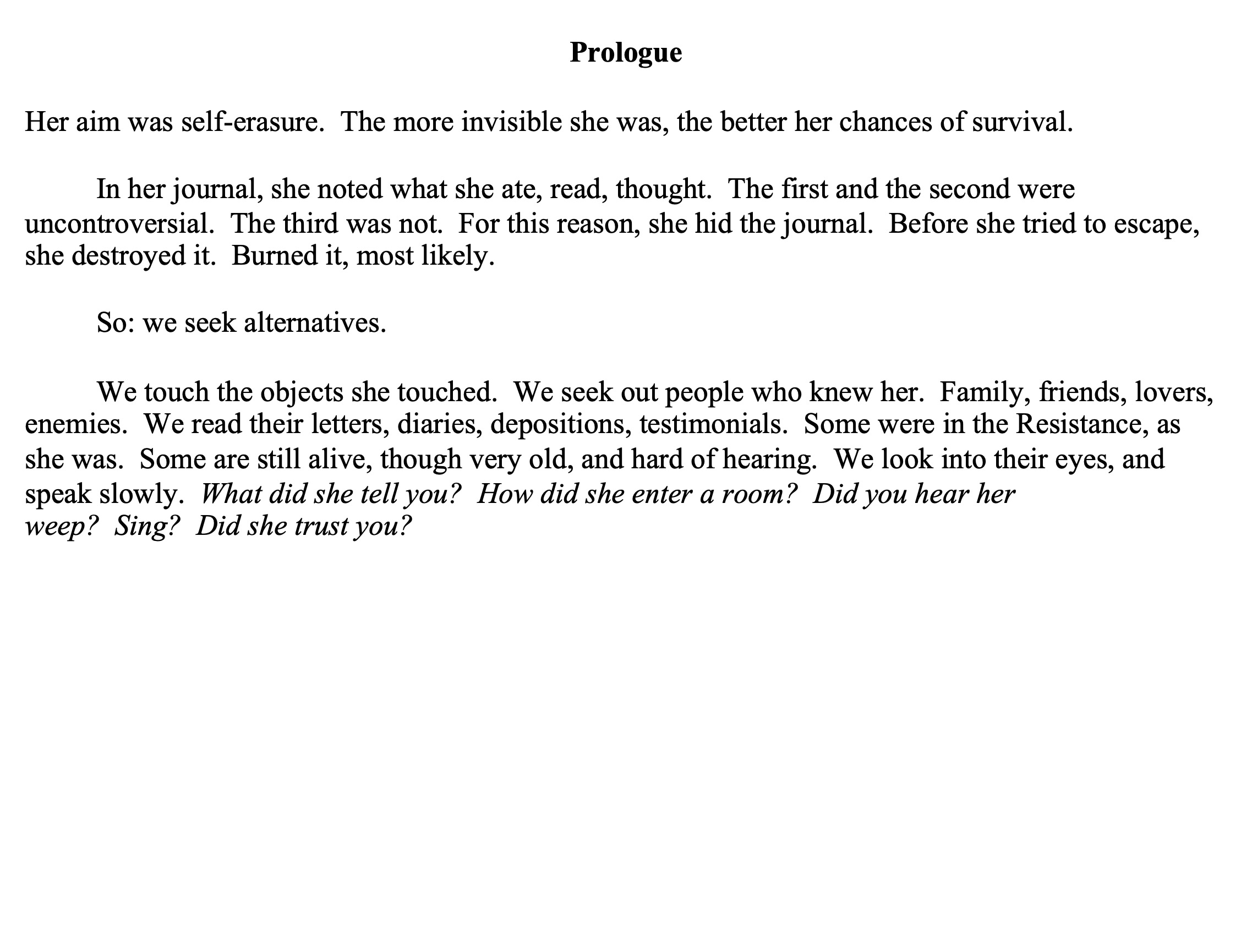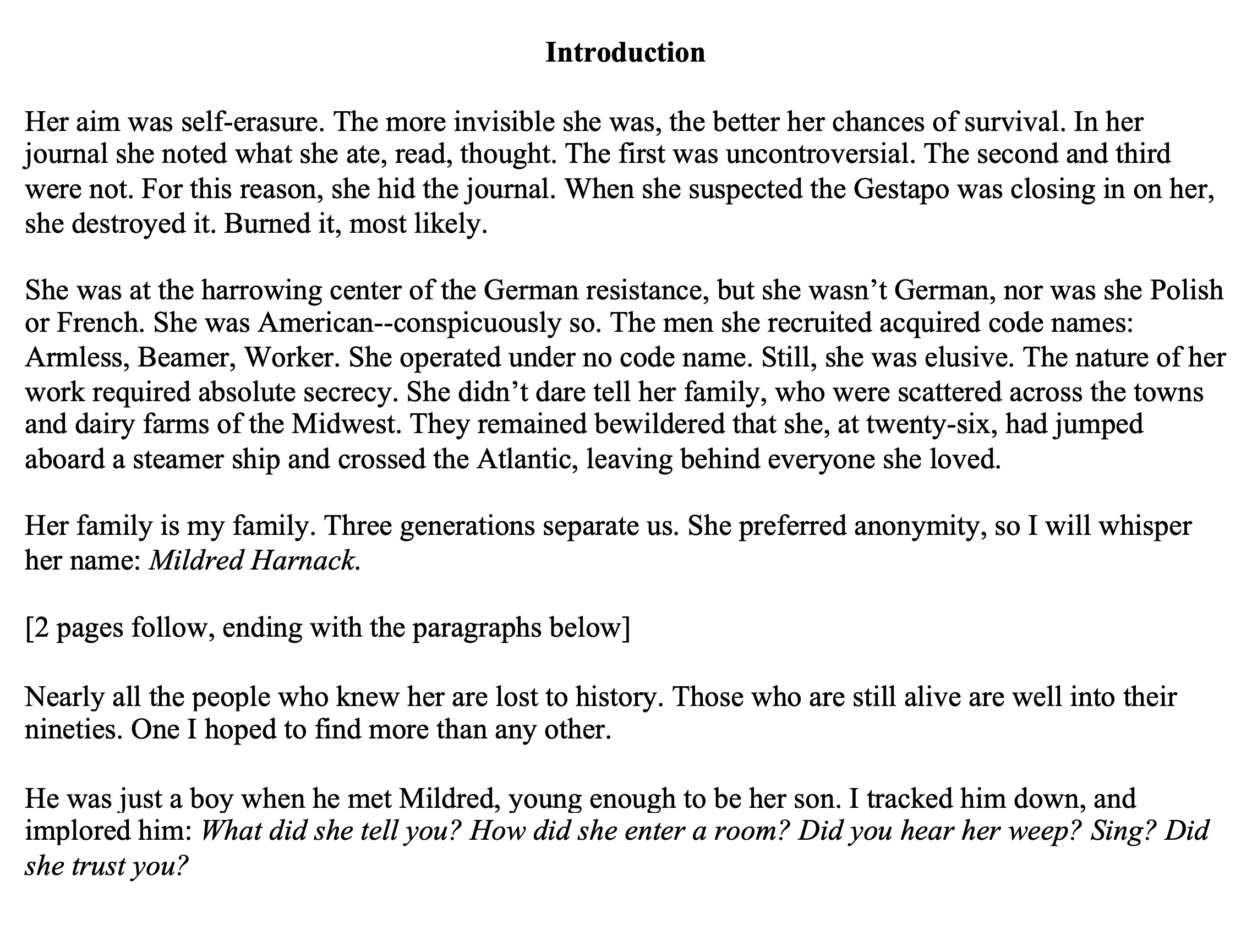

Reading Rebecca Donner’s stunning nonfiction book, All the Frequent Troubles of Our Days, I felt like I was in the passenger seat of a car, trying to jam my foot on the brake. From the very beginning, we know how the story ends: the central figure, Mildred Harnack, an American who fought in the underground German resistance in the years preceding and during World War II, is captured and beheaded on Hitler’s order. Donner unspools her narrative with deftness and considerable tension, drawing us deeper into Harnack’s gripping story to reveal a contrast of dark and light, sorrow and rebellion.
For Donner, that story is a personal one: Mildred Harnack was her great-great-aunt. When Donner turned sixteen, her grandmother gave her a small stack of Harnack’s letters. She made Donner promise to write Harnack’s story one day. “It was always a question of when,” Donner says, “not if.”
It is particularly difficult to research historical figures who have been left out or actively erased from history; sometimes the material is so full of holes the gaps overwhelm the certainties. I talked to Donner about her revision process and the challenge of writing about a misunderstood figure whose material records have not been well-preserved. Even with the author’s family connection, Harnack proved a particularly tricky subject: “Her aim was self-erasure.”
—Tana Wojczuk for Guernica
Guernica: Did you always plan to begin the book with the problem of erasure?
Rebecca Donner: Yes, I was acutely aware that Mildred Harnack had been erased numerous times. She was at the center of Berlin’s underground resistance to the Nazi regime for over a decade, and after the Gestapo tracked her down Hitler personally ordered her execution. High-ranking Nazi officials destroyed records documenting the torture she suffered during Gestapo interrogations prior to her execution. The US Army’s Counterintelligence Corps buried her case for over fifty years. My great-grandmother, Harriette, ordered the family to burn Mildred’s letters and photographs after Mildred was executed. I found it terribly poignant that Mildred participated in her own erasure as well, for the sake of survival. Living in a fascist dictatorship while secretly undermining it meant that she had to accustom herself to concealment; when she became involved in espionage during the Second World War she had to perform all sorts of masquerades. She burned her journal shortly before the Gestapo arrested her — another act of erasure. So, I began this book with the idea that I was writing about a woman who had been erased and who also had enacted her own erasure. I knew that there were gaps in the historical record, which posed a number of artistic challenges, of course.
Guernica: How did the book come about?
Donner: When I was sixteen, my grandmother gave me [what remained of] Mildred Harnack’s letters. I always knew I would write this book, and began working on it after my second book was published. I conducted extensive archival research in Berlin, Moscow, London, and Washington, DC.
Guernica: Even with all that research, I imagine many holes remained. How did you handle that?
Donner: I approached this book as a scholarly detective story. I filled in the gaps where I could, and where there was no historical record I allowed the gaps to show, the silences to resonate. I also looked for creative ways to illustrate how people remembered or misremembered Mildred. In the chapter “Fair, Bright, Transparent,” for example, I feature a photograph of an unpublished essay written by Mildred’s friend Martha Dodd, which I discovered among Dodd’s papers at the Library of Congress. Martha doesn’t quite remember how they met; in the essay you can see her cross-outs, all her abortive attempts to describe Mildred.
Guernica: I was struck by the contemporary relevance of Mildred’s resistance to the rise of fascism in Germany. In particular, I was struck by a letter that reads:
Donner: Mildred wrote that letter on October 18, 1932, a few months before Hitler was appointed chancellor of Germany. The parallels between then and now are striking. Many conservatives in the German government believed that Hitler was a buffoon and could be controlled.
Guernica: I was surprised to learn more about the Weimar Republic, about the great artistic and social freedoms Germans had before Hitler’s rise.
Donner: Before Hitler took power, Germany was a parliamentary democracy with a constitution that granted citizens freedom of speech, freedom of the press, and freedom to assemble peacefully and endowed women with the same fundamental rights as men, including the right to vote and hold public office. It was important to me to show what was lost.
Guernica: I admire how you handle the more gruesome aspects of the book: You don’t shy away from them, but you also avoid sensationalizing. You are particularly careful about how you deal with Mildred’s death. Instead of showing her beheading, you cut from her in prison to a chapter on the creation of the guillotine.
Donner: I approached the beheading from multiple perspectives. When Mildred was thrown in solitary confinement prior to her beheading she wasn’t permitted to write any letters, so I had to draw on other primary-source documents to chronicle the last few months of her life. I created a collage-effect with a series of notes I discovered in a Berlin archive written by women in her resistance group who were also incarcerated. Rhythmically and tonally, the chapter describing the creation of the guillotine and the chapter describing Mildred in prison are starkly different. I wanted to contrast something dark with a burst of energy.
Guernica: These techniques remind me of poetry, though the book also has a strong narrative drive.
Donner: I did think about poetry when writing the book. The title is a line from a Goethe poem that Mildred was translating in her prison cell shortly before her beheading. In an early draft I tried dismantling the poem and structuring the narrative around it. Poetry is so central to who Mildred is: She and her husband, Arvid, memorized poems by Goethe and Whitman and recited them to each other. One of their co-conspirators described in a memoir how Mildred was always walking around muttering Shakespeare.
Guernica: You write in the prologue that her reading was “controversial.” Can you say more about that?
Donner: During the early 1930s, Mildred lectured at the University of Berlin about American novelists who opposed capitalism, including John Dos Passos and Sinclair Lewis, and she lent her copy of Lenin’s The State and Revolution to students she recruited into her underground resistance group. On May 10, 1933, roughly three and a half months after Hitler became chancellor of Germany, books by Dos Passos, Lewis, and Lenin were among those that Nazi student groups torched in bonfires across thirty-four university towns in Germany. The burnings were considered a Säuberung — a cleansing — that would symbolically purify German language and literature of “un‑German” authors, including Jews, Communists, and pacifists. If Mildred continued lecturing about these books, she could have been arrested by the Gestapo. Reading became a dangerous act, and an act of resistance.
Guernica: In your revision, the emphasis shifts from an inclusive “we” to a more narrative, historical perspective. The effect is to introduce more detail about Harnack, but also to underscore our distance from her in time. It creates a wonderful tension. How did you make the decision to foreground the historical context in the second paragraph?
Donner: I decided that it was important to anchor these elusive introductory sentences with something concrete and provide at least a hint of historical context. I wanted to give the reader a clear sense of who she was (“at the harrowing center of the German resistance”) while also withholding information to create an atmosphere of suspense and amplify the idea that she participated in her own self-erasure. There’s a delicate balance between revealing and concealing in these sentences. I don’t disclose her name until the third paragraph. The idea that I would “whisper” it came to me after I had been working on the manuscript for about two years. I was dogged in my effort to nail the introduction, and revised it over and over again – nearly two hundred times. It goes without saying that revision is an essential part of my process.
To read more interviews from our Back Draft archive, click here.